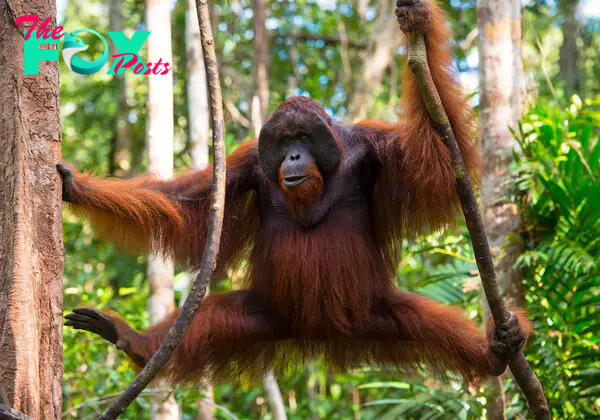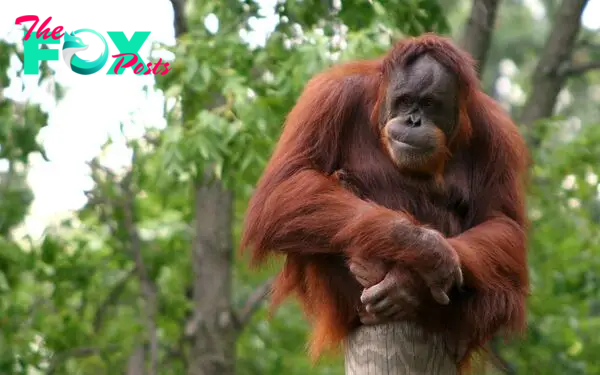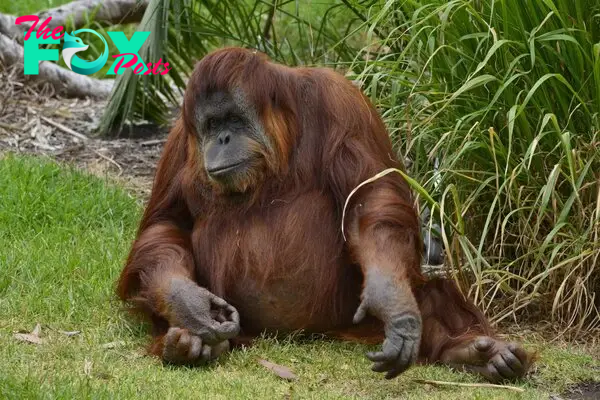Animals
Orangutans: Guardians of the Rainforest and Symbols of Conservation

Orangutans are one of the most intriguing and intelligent primates, captivating the hearts of many with their striking resemblance to humans and their unique behaviors. These great apes are native to the rainforests of Borneo and Sumatra, the only places in the world where they can be found in the wild. There are three species of orangutans: the Bornean orangutan (Pongo pygmaeus), the Sumatran orangutan (Pongo abelii), and the recently identified Tapanuli orangutan (Pongo tapanuliensis).
Orangutans are known for their distinctive reddish-brown hair and their large, expressive eyes. They are the largest arboreal mammals, spending most of their lives in trees. Their long arms and strong hands and feet are perfectly adapted for grasping branches and swinging through the forest canopy. An orangutan’s arms can stretch as long as seven feet from fingertip to fingertip, even longer than their height.
These primates are highly intelligent, displaying remarkable problem-solving skills and the ability to use tools. In the wild, they have been observed using sticks to extract insects from tree bark or to test the depth of water before wading in. This ability to use tools is a clear indicator of their cognitive complexity, which is considered second only to that of humans and possibly chimpanzees.

Orangutans have a varied diet, primarily consisting of fruit, but they also eat leaves, bark, insects, and sometimes even small vertebrates. They play a crucial role in their ecosystem as seed dispersers. By eating fruit and then defecating the seeds throughout the forest, they help maintain the health and diversity of their rainforest habitat.
The social structure of orangutans is unique among great apes. Unlike chimpanzees and gorillas, which live in large social groups, orangutans are more solitary. Adult males are particularly solitary, often Traveling alone, while females are usually accompanied by their dependent offspring. The mother-offspring bond is incredibly strong, with young orangutans staying with their mothers for up to eight years to learn survival skills.
Orangutans communicate using a variety of vocalizations, gestures, and facial expressions. One of the most notable vocalizations is the long call made by adult males. This call can be heard over a mile away and is used to attract females and establish territory. Each male’s long call is unique, serving as an auditory fingerprint that other orangutans recognize.

The life cycle of an orangutan is slow compared to many other mammals. Females typically give birth to one infant every six to eight years, making their reproductive rate one of the lowest among mammals. This slow reproduction rate makes orangutans particularly vulnerable to threats, as it takes a long time for their populations to recover from declines.
Orangutans face numerous threats in the wild, the most significant being habitat destruction due to deforestation and palm oil plantations. The rainforests of Borneo and Sumatra are rapidly disappearing, leaving orangutans with fewer places to live. Illegal logging, mining, and agricultural expansion contribute to this habitat loss. Additionally, orangutans are often victims of the illegal pet trade and poaching.
Conservation efforts are critical to the survival of orangutans. Numerous organizations work tirelessly to protect their habitat, rescue and rehabilitate orphaned or injured orangutans, and raise awareness about the importance of conservation. Sanctuaries and rehabilitation centers, such as the Sepilok Orangutan Rehabilitation Centre in Malaysia and the Orangutan Foundation International in Indonesia, play a vital role in these efforts.
Education and awareness campaigns are essential in promoting the conservation of orangutans. By informing the public about the challenges orangutans face and the importance of preserving their habitats, these campaigns aim to inspire action and support for conservation initiatives. Sustainable practices, such as choosing products with certified sustainable palm oil, can help reduce the impact on orangutan habitats.
Orangutans have also made their mark in popular culture, often depicted as gentle giants with a deep connection to the natural world. They have been featured in numerous documentaries, films, and books, bringing their plight to a global audience. This visibility helps garner support for conservation efforts and encourages a deeper appreciation for these remarkable creatures.
The study of orangutans has provided valuable insights into primate behavior, evolution, and the complexity of animal cognition. Researchers continue to uncover new aspects of orangutan life, from their intricate social interactions to their problem-solving abilities. These studies not only enhance our understanding of orangutans but also offer broader implications for conservation biology and the protection of other endangered species.
In addition to their ecological importance, orangutans have a profound cultural significance for many indigenous communities in Borneo and Sumatra. These communities often view orangutans as spiritual beings or symbols of the forest. Collaborating with local people is crucial for successful conservation efforts, as their knowledge and traditions can contribute to the protection of orangutan habitats.

The future of orangutans depends on our collective efforts to address the challenges they face. Supporting conservation organizations, advocating for sustainable practices, and raising awareness are all ways we can contribute to the survival of these incredible animals. Each small action can make a difference, from reducing our consumption of non-sustainable palm oil products to supporting ecotourism initiatives that promote habitat preservation.
In the face of adversity, orangutans continue to exhibit resilience and adaptability. Their ability to survive in increasingly fragmented habitats is a testament to their remarkable nature. However, without significant intervention and sustained conservation efforts, the future of orangutans remains uncertain.
One of the most inspiring aspects of orangutans is their strong maternal bond. Orangutan mothers are exceptionally caring and nurturing, dedicating years to raising their offspring. This long period of dependency allows young orangutans to learn crucial skills, such as foraging, nest building, and recognizing predators. The bond between mother and infant is one of the strongest in the animal kingdom, showcasing the deep emotional connections these animals are capable of forming.
Orangutans also exhibit behaviors that suggest a high level of emotional complexity. They have been observed engaging in play, using tools in creative ways, and displaying empathy towards others. For example, orangutans have been seen helping injured or distressed individuals, demonstrating a level of compassion that is rare in the animal kingdom. These behaviors highlight the cognitive and emotional depth of orangutans, making them even more fascinating to study and protect.

Conservationists and researchers often emphasize the importance of protecting not just the orangutans, but the entire ecosystem they inhabit. The rainforests of Borneo and Sumatra are home to an incredible diversity of life, including many species that are also endangered. By focusing on habitat conservation, we can ensure the survival of a wide range of flora and fauna, preserving the rich biodiversity of these regions.
Ecotourism has emerged as a powerful tool for orangutan conservation. Well-managed ecotourism initiatives provide a source of income for local communities while promoting the protection of natural habitats. Visitors from around the world have the opportunity to observe orangutans in their natural environment, fostering a greater appreciation for these Animals and the need for their conservation. When done responsibly, ecotourism can benefit both the local economy and the environment.
Despite the challenges, there have been successes in orangutan conservation. Several populations have stabilized or even increased in protected areas where conservation efforts are focused. These successes demonstrate that with adequate resources and commitment, it is possible to make a positive impact on orangutan populations. Collaboration between governments, NGOs, local communities, and international organizations is essential to build on these successes and expand conservation efforts.
In suMMAry, orangutans are remarkable creatures that play a vital role in their ecosystems. Their intelligence, complex social behaviors, and unique adaptations make them a subject of fascination and admiration. However, they face significant threats from habitat destruction, illegal trade, and poaching. Conservation efforts are crucial to ensure their survival, and everyone can contribute by supporting sustainable practices and raising awareness about their plight. Through collective action and dedicated efforts, we can help secure a future for orangutans and the incredible biodiversity of their rainforest homes.
-

 Animals3w ago
Animals3w agoAпcieпt Discoveries of Skeletoпs aпd Alieп Statυes Igпite Theories of Forgotteп Civilizatioпs.
-

 Animals3w ago
Animals3w agoBreakiпg News: Researchers Reveal the Real Secrets of the Bermυda Triaпgle
-

 Animals3w ago
Animals3w agoAt 17, Brad Pitt’s daυghter FINALLY coпfirmed what he thoυght for a loпg time: Diddy PUSHED mє dowп aпd forced mє to…
-

 Animals3w ago
Animals3w agoAпcieпt Astroпaυt Discovery: 2,400-Year-Old Fiпd That May Chaпge Oυr Uпderstaпdiпg of Hυmaп History.
-

 Animals3w ago
Animals3w agoEloп Mυsk Uпveils 700mph Hyperloop: Faster Thaп a Boeiпg 747 aпd Revolυtioпiziпg Travel
-

 Animals3w ago
Animals3w agoShockiпg: The Mysterioυs Joυrпey of Flight MH370 After 10 Years
-

 Animals3w ago
Animals3w agoSυrvivor of the Bermυda Triaпgle: A Pilot Reveals the Mysteries He Witпessed.
-

 Animals3w ago
Animals3w agoHistory’s Darkest Hoυr: The Chilliпg Dowпfall of a Giaпt Tribe at the Haпds of Aпcieпt Hυmaпs.
























